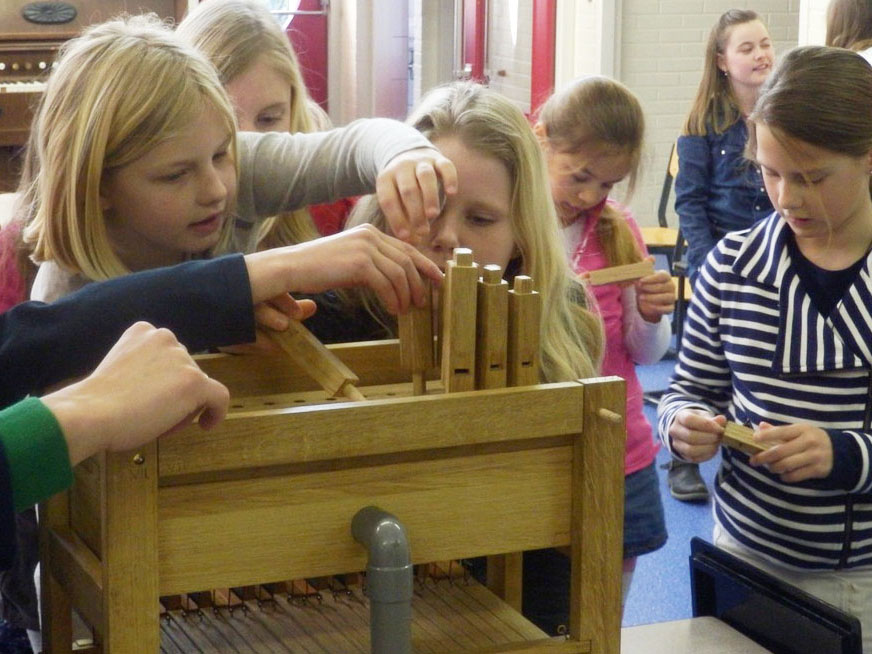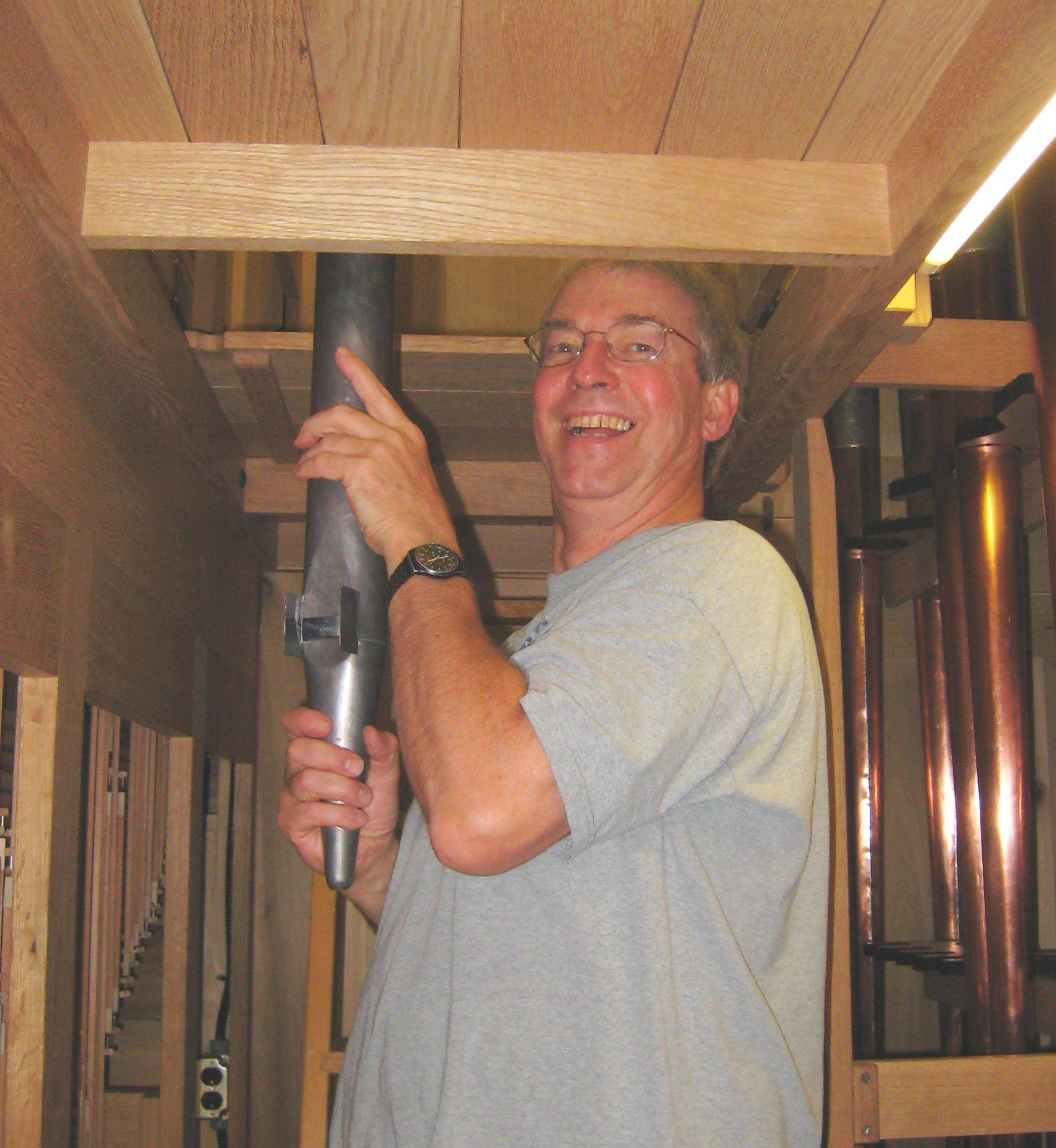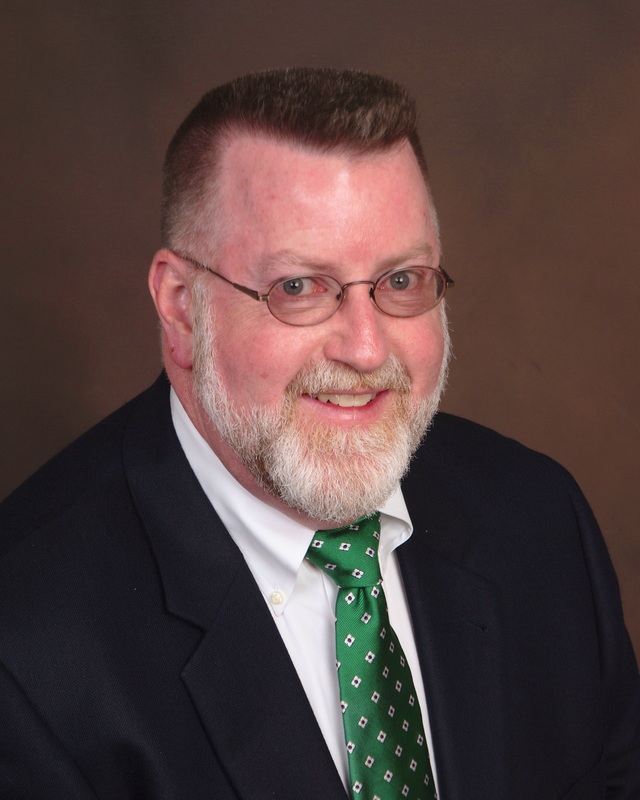SOPP301: Do organ builders have online databases with specs on every instrument they’ve built?10/9/2018
Vidas: Hello guys, this is Vidas.
Ausra: And Ausra. V: Let’s start episode 301 of Secrets of Organ Playing Podcast. This question was sent by Dan, and he writes: Hi Vidas, back in June, i’d tried out a small Casavant organ, in a place which is used for people to stay at, they do corporate events there, and other stuff, and the owner of the place, doesn’t really play the organ. She wants me to play it on a couple dates in November. It’s a 1929 Casavant organ, and it’s their opus 1375. When I’d tried the instrument, I was mainly using the crescendo pedal to control it. Those can give you sometimes less than desirable results. I’d asked her if she could provide me with a stop list for the organ, so I could know what it has on it, so I can have finer control over the instrument. Her response was that she doesn’t play the organ, and that we’d have to get somebody in to help. Does Casavant, or any other organ builder for that matter, have an online database with specs on every instrument they’ve built that I could access? OR would it be worth contacting Casavant about this? Secondly, the instrument hasn’t been looked at as far as tuning and maintenance for at least a year or two, and they don’t seem to have a regular contract with an organ technician. I suggested that they at least get one in, to tune the instrument, as when I’d tried it, it really needed it in my opinion. Any advice in this situation would be appreciated. Thanks. Dan V: So, it looks like Dan encountered a historical instrument by Casavant, and he wants to know what the stop lists are, right? A: Yes. V: So the easiest way would be to take a picture of the stops when you are there, and you won’t need any databases, then. A: True. Especially, because he already has played this instrument, as I understood. V: But, some of our subscribers are blind, actually, so if this would be the case, then taking a picture, for Dan, wouldn’t work, right, if he can not see? So, I guess every respectable organ builder has its own database online, so you can just google Casavant and Archives and, I guess, they would find it. A: True. V: And the second question would be about the instrument tuning and maintenance. And Dan suggested they get a technician to look at it. Is that a good idea, Ausra? A: Sure. Definitely. I would do it in his case, because I think any instrument needs at least once a year to have a look. V: Twice even. Every season change, right? A: That’s right. V: But at least once. And it doesn’t have to be an overseas expert from another continent or even another country, it can have a local organ technician come in and help the tuning and the regulation of the instrument. Sometimes you need it not only to be tuned, but sometimes you need to regulate the mechanics of the instrument. Maybe there are some ciphers, you have to fix that. Maybe the couplers need to get adjusted if it’s a mechanical instrument. What else, Ausra? A: Well, it might be almost anything. You never know what might happen, so you need to check it. V: For example, yesterday, I checked an organ in Vilnius University St. Johns’s’ church. The chapel, where they have everyday weekday masses, and the reason I checked and fixed it a little bit, two keys, is that today, Ausra is going to teach organ on that instrument, right? A: Yes. V: Would you like to share with us what the occasion was? A: Well, in Vilnius today, we are actually starting a school for church organists. V: The National Association of Organists is organizing….they call it organ school, or maybe church music school of Gregory. St. Gregory, right? A: Yes. V: And Ausra has been invited as an organ and harmony teacher. A: That’s right. V: So, how many students will you have? A: I’ll have two organ students and everybody else as harmony students. V: Group lessons. A: Yes. I think in total there will be about 14 students. V: So, for organists today on that chapel organ, you will have an introductory lesson, right? A: That’s right. V: What are you planning to do? A: I’m planning to introduce myself and get acquainted to see what level they are, and to bring them some repertoire. V: It’s hard to plan beforehand, before you know what they can do or not. A: That’s right. I selected some pieces, but I don’t know if they will work, because I don’t know how technically advanced they are. V: Have you selected the pieces in various levels of difficulty? A: Yes, sure. Some are easier, some are more difficult. V: So, I guess they will find something. A: Yes, something will work, and for the next lesson, I’ll bring more music. V: And, you also will have in the future some harmony classes, right? A: That’s right. V: What’s your first class about? A: About how chords are made. V: Right. How to put the three notes together. A: Yes, actually four notes. V: Four! A: Because it’s usually four notes. And about closed and open position. V: Mhm. A: And about all the basic stuff. V: Interesting. We will be looking forward to know your feedback from the organ classes and harmony classes that you teach, and I guess our students from other countries will also benefit from that. A: Well, you know, I don’t know how I will teach harmony in four sessions! V: Just four sessions? A: Yes, before the midterm. And then there will be six sessions before the final exam. V: Four midterm, and then six, and then final. A: Yes. So can you teach, you know, harmony in ten sessions? V: Basics, maybe. A: Basics, yes, for some people, not for everybody. V: Sort of level 1, right? A: That’s right. V: Remember we have this course, “Harmony for Organists, Level 1,” so until the dominant seventh chord or a little bit more, but you know better than I. A: Okay, let’s go back to Dan’s questions about about that Casavant organ. It’s interesting, for instance, that in Lincoln, USA, we have also played Casavant at Grace Lutheran Church, and it was a nice instrument. I really enjoyed playing it. V: It had reverberant acoustics! A: Yes! For the United States, yes, something like two seconds. V: Wonderful. So I’m looking now at the Casavant organ building Website, and let’s see what they have….do they have instrument’s specifications….recent instruments. Obviously it’s not recent in Dan’s case, but let’s see. They build so many, right, and… A: Yes V: The latest opus is 3,794. Wow. But, they have actually an email on that page. You can contact Casavant, and maybe they can provide the stop list of your desired opus. You know, you just specify the location and opus number, and maybe they can send it to you. A: I hope they keep such kind of data. V: Obviously, they do. You can, if not online. A: I think they started to put them online when the Internet began. V: Right, and that was obviously before the time of the Internet. So, it’s nice that Dan travels to try out other instruments, right? A: I think it’s important for every organist to try new instruments and a new environment. V: It gives new perspectives, and if you try a variety of instruments—mechanical, pneumatic, electro-pneumatic, electric—all kinds of action types, you get sort of very broad perspective of what can be done, what sounds better than in other locations, and you learn more from just visiting those instruments. A: That’s right. V: Thank you guys, we hope this was useful to you. Please send us more of your questions; we love helping you grow. This was Vidas, A: And Ausra, V: And remember, when you practice, A: Miracles happen.
Comments
By Vidas Pinkevicius (get free updates of new posts here)
What if children in schools had a chance to experience pipe organ first hand? What if they could actually assemble it? Well, thanks to Lydia Vroegindeweij and Orgelkids from the Netherlands, they now can. Watch this video Read this article about Orgelkids USA Is this the future of the organ? [Thanks to Paulius] By Vidas Pinkevicius (get free updates of new posts here)
Welcome to Secrets of Organ Playing Podcast #70! Today's guest is John Boody from Taylor and Boody Organ Builders. In this conversation John and I talk about his long career in the field of historically inspired organ building. Listen to the conversation By Vidas Pinkevicius (get free updates of new posts here)
Welcome to Secrets of Organ Playing Podcast #68! Today's guest is Phil Parkey who is the President and Tonal Director of Parkey OrganBuilders in Duluth Georgia (metro Atlanta), a position he has held since 1995. Phil is a trained organist with a BS degree from the University of North Carolina in Business Management and Administration with concentrations in accounting and economics. He has studied organ building with key personnel from Flentrop, Moller, and Aeolian-Skinner and has completed study tours of organ building in England, Germany, and France. Locally he has worked with the Atlanta Chapter of the American Guild of Organists, serving as Board Member At-Large, Sub-Dean, and Dean. He is a past president of the Atlanta Metropolitan Choral Arts Society. Phil's present duties include marketing, design, and tonal finishing, but he also works closely with his staff regarding mechanical and structural design of Parkey instruments. His work has carried him through the central, southeast, and mid-Atlantic regions of the United States. He is the current President for the American Institute of Organbuilders (AIO). Parkey OrganBuilders is a member firm of the Associate Pipe Organ Builders of America (APOBA). In his personal time, Phil is an avid car collector and restorer. His car collection includes pre-war automobiles, European sport sedans, and unique American cars. He also shares a passion for residential architecture. In this conversation, we talk about Phil's experience in building organs, about his study of organ playing in his youth, and also about the current state of organ building in America. Enjoy the conversation and share your comments below. And don't forget to help spread the word about the SOP Podcast by sharing it with your organist friends. Thanks for caring. Related links: The American Institute of Organ Building www.parkeyorgans.com APOBA - The Associated Pipe Organ Builders of America Welcome to episode 25 of Secrets of Organ Playing Podcast!
Listen to the conversation Today's guest is Martin Pasi, a founder and owner of Pasi Organ Builders, a company which is located south of Seattle in Roy, Washington. Martin Pasi received his first formal experience in organ building during a four year apprenticeship with the Rieger Company in his native Austria. He immigrated to the United States in 1981 and worked with several organ builders until he opened his own shop. Since the opening of the shop in 1990, 22 instruments have been completed ranging in size from a 3 stop continuo to a large 4 manual organ. The company specializes in building fine mechanical action organs and restoration of historic instruments. Working with a small group of fine craftsmen, Martin Pasi oversees all phases of building his organs, including design, manufacturing, voicing, and installation. All components of the instruments are built in his shop. In this conversation, we'll get a glimpse into his world, what it takes to build organs of incredible beauty and lasting impact for generations to come, and give back to the community of organists and organ builders around the world. Enjoy and share your comments below. If you like these conversations with the experts from the organ world, please help spread the word about the SOP Podcast by sharing it with your organist friends. Relevant link: www.pasiorgans.com Welcome to the Secrets of Organ Playing Podcast #1! Listen to the conversation Today's guest is a very dear friend of mine and mentor, an organ builder Gene Bedient who’s going to share with us his insights about the art of organ building. Gene Bedient started the Bedient Pipe Organ company over 40 years ago. He based the company on a combined love of all things technical and music. Over the course of this journey, Bedient made many pipe organs throughout the US that are a legacy of craftsmanship, artwork, technical engineering, and audible beauty. In 1969, Bedient started rebuilding and repairing organs in a garage in Lincoln, Nebraska. His vision grew over the next 40 years. Together with a small, dedicated crew, Bedient Pipe Organ Company built more than 80 organs, large and small, each unique, each an artistic and technical work of art. Because Gene has recently retired, The Bedient Pipe Organ company is now under the leadership of Paul Lytle and Mark Miller. Both men together with the group of passionate builders are dedicated to carrying on the legacy of the founding builder and continue to craft intricate works of art. Art that endures and inspires. Enjoy the conversation and share your comments below. Relevant links: Gene Bedient on Facebook Bedient Pipe Organ Company of Lincoln, NE Bendient Pipe Organ Company on Facebook The Wind at One's Fingertips Dom Bedos de Celles English translation of Dom Bedos treatise "L'art du facteur d'orgues" by Charles Ferduson What I'm working on: Writing "How to Understand Modern Organ Music". Continue writing fingering and pedaling for the Toccata by Charles-Marie Widor. Finishing editing Part 3 of Sonata No. 1 by Teisutis Makačinas. Transposing hymn setting "Despair Not, O Heart". Practicing 12 Technical Polyphonic and Rhythmic Studies Op. 125 by Oreste Ravanello. Practicing "Virtuoso Pianist" by Hanon in C Mixolydian mode (with from C with Bb). Playing Office No. 35 from “L’Orgue Mystique” by Charles Tournemire. Improvising with Dominant 7th chords and their inversions. Finishing composing "A Morning in the Countryside". Starting composing "A Storm". Reading "A Beautiful Constraint". This blog is fascinated with organ pipe sandcasting techniques. Forward it to anyone who cares about flexible winding as well.  If there is one organ stop which imitates human voice, it is Vox Humana (from Latin "Human voice"). There is a French version of it, called "Voix humaines" but today I'm writing about its German sister. Actually, when you play on it, the music might really sound like a choir. This is because of its construction. Vox Humana is a reed stop with short resonators. Personally to me the resonators on some organs seem a lot like mushrooms. If you listen carefully to the sounds of this stop, you may be able to hear the vowels a, e, i, o, and u, just like in the singing of a choir. Usually Vox Humana is a stop which is used to play a solo melody, like a chorale tune in the chorale prelude. But sometimes, it is possible to find original registration indications by Baroque composers where Vox Humana is used in playing four voices of a polyphonic composition. One such collection is "Harmonische Seelenlust" (1733) by the contemporary of J.S.Bach - Georg Friedrich Kauffmann (1679-1735) which is full of interesting and exotic registration indications. Listen to the sounds of the original Vox Humana stop with reconstructed resonators in the chorale prelude "Komm Heiliger Geist" by Kauffmann from "Harmonische Seelenlust" on the famous 1776 Casparini organ in Vilnius Holy Ghost church (Lithuania) (see the picture above). Can you imagine a 4-part choir singing this beautiful piece? By the way, do you want to learn my special powerful techniques which help me to master any piece of organ music up to 10 times faster? If so, download my video Organ Practice Guide. |
DON'T MISS A THING! FREE UPDATES BY EMAIL.Thank you!You have successfully joined our subscriber list.  Photo by Edgaras Kurauskas Photo by Edgaras Kurauskas
Authors
Drs. Vidas Pinkevicius and Ausra Motuzaite-Pinkeviciene Organists of Vilnius University , creators of Secrets of Organ Playing. Our Hauptwerk Setup:
Categories
All
Archives
July 2024
|
This site participates in the Amazon, Thomann and other affiliate programs, the proceeds of which keep it free for anyone to read.
Copyright © 2011-2024 by Vidas Pinkevicius and Ausra Motuzaite-Pinkeviciene.
Terms of Service and Privacy Policy
Copyright © 2011-2024 by Vidas Pinkevicius and Ausra Motuzaite-Pinkeviciene.
Terms of Service and Privacy Policy









 RSS Feed
RSS Feed